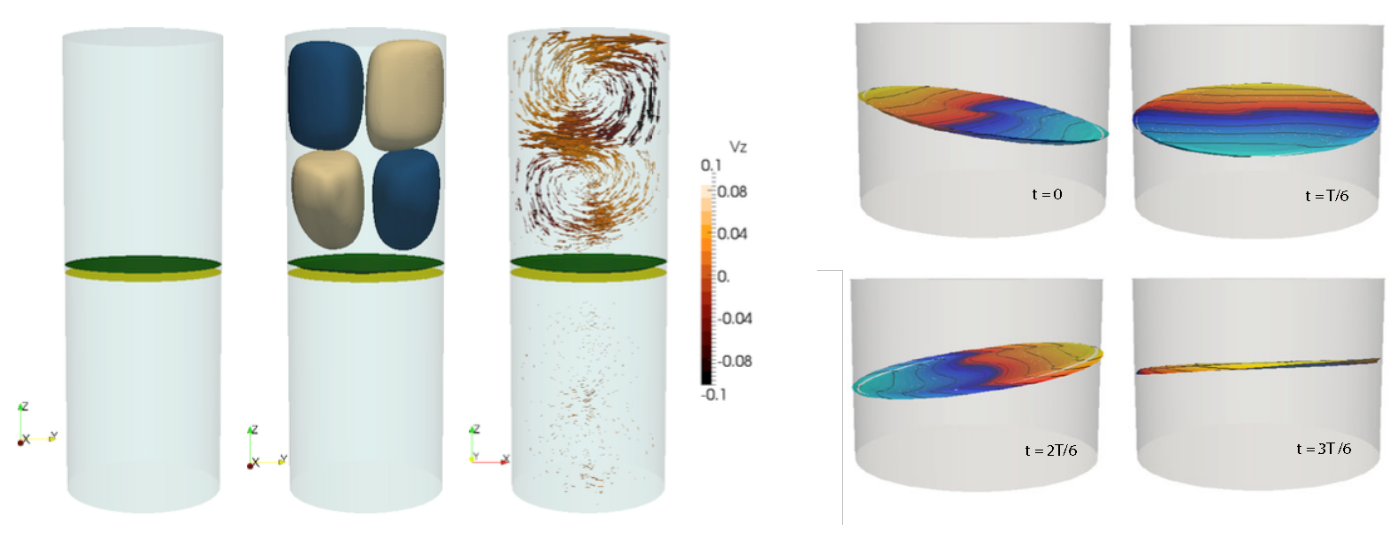COMET
MagnétoHydroDynamiC
The equations of magnetohydrodynamics (MHDMagnétohydrodynamique) describing the motion of an electrically conductive fluid couple the velocity and magnetic induction fields by the Lorentz force and Ohm’s law.
Using an MHDMagnétohydrodynamique code developed at LIMSILaboratoire d'Informatique pour la Mécanique et les Sciences de l'Ingénieur, créé en 1972 et dont les équipes ont rejoint celles du LRI en 2021 pour fonder le LISN. coupled with innovative analytical models, we develop this topic along three main axes:
Wind and solar energy are promising for our future but are generated intermittently. To optimize their use, it is important to develop massive energy storage technologies. To meet this need, D. Sadoway’s group (MIT Boston) proposes to use large liquid metal batteries. As in a classical battery, the electrical energy is stored in electro-chemical form, using an anode-electrolyte-cathode triplet consisting of liquid metals and electrolyte of different mass densities which, in the gravity field, organize themselves into layers. However, MHDMagnétohydrodynamique instabilities can be triggered in the liquid metals during the charge-discharge phases but also at the interfaces and cause movements that can induce short circuits. In the period 2014-15, we studied an MHDMagnétohydrodynamique instability called Tayler theoretically and numerically. For this, we implemented the level-set method in the numerical code SFEMaNS (collab. J.-L. Guermond, TAMUTexas A&M University, Texas) of LIMSILaboratoire d'Informatique pour la Mécanique et les Sciences de l'Ingénieur, créé en 1972 et dont les équipes ont rejoint celles du LRI en 2021 pour fonder le LISN.. This work has allowed us to define safe regimes for the operation of a liquid metal battery, with respect to the Tayler instability (see figure on the left). Subsequently, we have shown the importance of the Metal Pad Roll instability which generates a rotating wave at the interface between two liquid metals. An example of a direct simulation of this instability in an electrolysis cell is shown in the figure on the right. This work benefits from the collaboration with the HZDR of Dresden (N. Weber, F. Stefani, T. Weier), where experiments on batteries are under construction.
The Von Kármán Sodium experiment studies the generation of a magnetic field by a turbulent flow of liquid sodium driven by two contra-rotating turbines (discs and blades). It is the only one to have obtained dynamo regimes with a magnetic field reversing in the course of time like the terrestrial field but, for that, the turbines must be made of soft iron. The role of this ferromagnetic material remains mysterious and we propose to bring elements of answer by relying on the SFEMaNS code (collab. J.-L. Guermond, TAMUTexas A&M University, Texas). The scientific obstacles are firstly the consideration of iron turbines corresponding to an azimuthal variation of the magnetic permeability but also the high kinetic Reynolds numbers of the experiment (107).
The method used to remove the first lock is to consider an axisymmetric mean permeability and to treat the azimuthal variations as a source term of the induction equation (L. Cappanera thesis, EDEcole Doctorale SMEMaG 2013-2016). In the simplified case of the kinematic dynamo where the velocity field is assumed to be constant, a numerical code developed at GeePs (ex-LGEP) and LIMSILaboratoire d'Informatique pour la Mécanique et les Sciences de l'Ingénieur, créé en 1972 et dont les équipes ont rejoint celles du LRI en 2021 pour fonder le LISN. and based on Nedelec elements has allowed to highlight the role of electromagnetic guide played by the ferromagnetic blades (Labex LaSIPS post-doc of H. Zaidi).
Another key ingredient is the helical vortex generated behind each blade: it collimates any pre-existing magnetic field creating an amplification of this field, more important for a ferromagnetic blade than a conductive one (InterLabex post-doc of J. Varela-Rodriguez). For the second lock, a non-linear stabilization technique allows to reach high kinetic Reynolds numbers. We have thus been able to perform the first realistic three-dimensional simulations of VKS (see figure).
We study the modeling and simulation of magnetic fluids in a heat transfer context (thesis of R. Zanella in co-supervision with GeePs, EDEcole Doctorale SMEMaG, funded by Labex LaSIPS). In particular, we are interested in the thermo-magnetic convection cooling of transformers immersed in ferrofluids, made of a vegetable oil (electrically insulating, non-magnetic and ecological) and ferromagnetic nanoparticles.
The mathematical model includes the following equations: magnetostatics, Navier-Stokes for a Newtonian and incompressible fluid and conservation of energy. Because of the magnetic nanoparticles, coupling terms appear: a forcing term in Navier-Stokes (Kelvin force) and terms making the magnetic field appear in the conservation of energy (Joule heating and pyromagnetic term). The temperature variation of the physical properties of the ferrofluid has a strong influence. These developments have been implemented in the SFEMaNS code (collab. J.-L. Guermond, TAMUTexas A&M University, Texas).
The numerical study is based on different transformer models, ranging from a simplified model (a solenoid immersed in a tank filled with ferrofluid, see figure) to primary and secondary circuits of various geometries. A ferromagnetic and laminated core can be added to approximate a real transformer and to increase the magnetic field in the fluid. The simplified model, experimentally studied at GeePs, allows to validate the numerical approach in the case of a vegetable oil. The same configuration with ferrofluid will be studied in the future.





